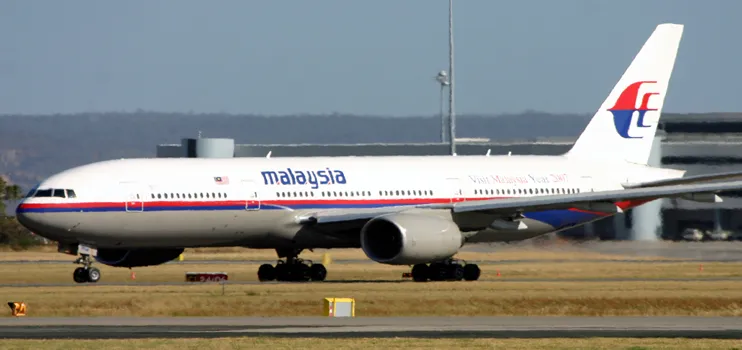
Malaysia Airlines 777 shot down
Jul 16, 2014

In July 2014, Malaysia Airlines Flight MH17, a Boeing 777, was tragically shot down over eastern Ukraine while en route from Amsterdam to Kuala Lumpur. The aircraft was struck by a surface-to-air missile, resulting in the deaths of all 298 passengers and crew on board. The incident occurred amidst ongoing conflict in the region, with investigations attributing responsibility to pro-Russian separatists. The tragedy highlighted the dangers of flying over conflict zones and led to widespread international condemnation and calls for accountability, ultimately affecting global aviation regulations and policies regarding airspace safety.
The tragic incident involving the Malaysia Airlines flight MH17, which was shot down over Eastern Ukraine on July 17, 2014, remains one of the most devastating events in modern aviation history. The Boeing 777 was en route from Amsterdam to Kuala Lumpur when it was struck by a surface-to-air missile, resulting in the loss of all 298 passengers and crew on board. This article delves into the details of the incident, the subsequent investigations, and its impact on aviation safety and international relations.
Background of Malaysia Airlines Flight MH17
Malaysia Airlines, the national carrier of Malaysia, operated the Boeing 777-200ER, which was a modern and reliable aircraft. The flight was carrying passengers from various countries, including the Netherlands, Malaysia, Australia, and Indonesia. As the aircraft flew over conflict zones in Ukraine, it tragically became a target for hostile actions.
Details of the Incident
On that fateful day, Malaysia Airlines flight MH17 was cruising at an altitude of approximately 33,000 feet when it was hit by a missile believed to have originated from separatist-controlled territory in Eastern Ukraine. The missile, identified as a BUK surface-to-air missile, caused the plane to break apart mid-air, resulting in a catastrophic loss of life.
Investigation and Findings
In the aftermath of the tragedy, an extensive international investigation was launched, involving multiple countries and agencies. The Joint Investigation Team (JIT), which included representatives from the Netherlands, Australia, Belgium, Malaysia, and Ukraine, worked to uncover the truth behind the incident. The investigation concluded that MH17 was shot down by a BUK missile system that had been brought into Ukraine from Russia.
Key Findings of the Joint Investigation Team
| Findings | Details |
|---|---|
| Missile Type | BUK 9M38 missile |
| Firing Location | Near Pervomaisk, Eastern Ukraine |
| Attribution | Russian military involvement |
| Casualties | 298 lives lost |
Impact on Aviation Safety
The shooting down of Malaysia Airlines flight MH17 raised significant concerns regarding aviation safety, particularly over conflict zones. In response to this event, regulatory bodies like the International Civil Aviation Organization (ICAO) began to emphasize the need for enhanced risk assessment for commercial flights flying over war-torn areas. Airlines were urged to reconsider their flight paths to avoid potential danger zones.
International Response and Legal Proceedings
The international community condemned the attack on MH17, and various countries demanded accountability for those responsible. As a result, several legal proceedings have been initiated, including the prosecution of individuals believed to be involved in the launch of the missile. The Dutch government has taken a leading role in pursuing justice for the victims' families, ensuring that the tragedy is not forgotten.
Repercussions on Malaysia Airlines
The incident had profound effects on Malaysia Airlines, which was already facing financial difficulties prior to the tragedy. The loss of flight MH17, along with the earlier disappearance of flight MH370, severely impacted the airline's reputation and operations. In an effort to recover from these crises, Malaysia Airlines implemented various reforms, including enhancing safety protocols and improving customer service.
Conclusion
The downing of Malaysia Airlines flight MH17 serves as a somber reminder of the potential dangers facing commercial aviation, particularly in regions of conflict. The ongoing investigations and legal proceedings highlight the necessity for accountability and justice for the victims and their families. As the aviation industry continues to adapt and implement safety measures, the legacy of MH17 will undoubtedly influence how airlines operate in the future.
In summary, the events surrounding the Malaysia Airlines 777 tragedy underscore the critical importance of aviation safety and international cooperation in preventing such disasters. Moving forward, the industry must prioritize passenger safety, ensuring that air travel remains one of the safest modes of transportation.
Related Articles

Explore Thailand: The Best Islands to Visit for Paradise, Adventure, and Relaxation

The Ultimate Guide to the Best Islands in Thailand for Your Next Getaway

Do babies need passports? How to get a passport for a newborn

How to get a U.S. passport fast: here’s how to expedite the process

What is Mobile Passport Control: 5 reasons why you should use it

SENTRI vs. Global Entry: A detailed guide

Do you need a passport to go to the Bahamas? Let’s find out

Do you need a passport to go to Mexico? A detailed guide

Do you need a passport to go to Canada? We got the answer

Do You Need a Passport for a Cruise: An Essential Travel Guide

Booster Seat Requirements: All the Rules to Follow in Your Rental Car

What Are the World’s Most Powerful Passports, and How Does Yours Rank?

How to Take a Passport Photo at Home: A Helpful Guide

You've got to have heart! Southwest's new livery

Your opinion: Should water be free on low cost carriers?

Young women bolder than guys as solo travellers
